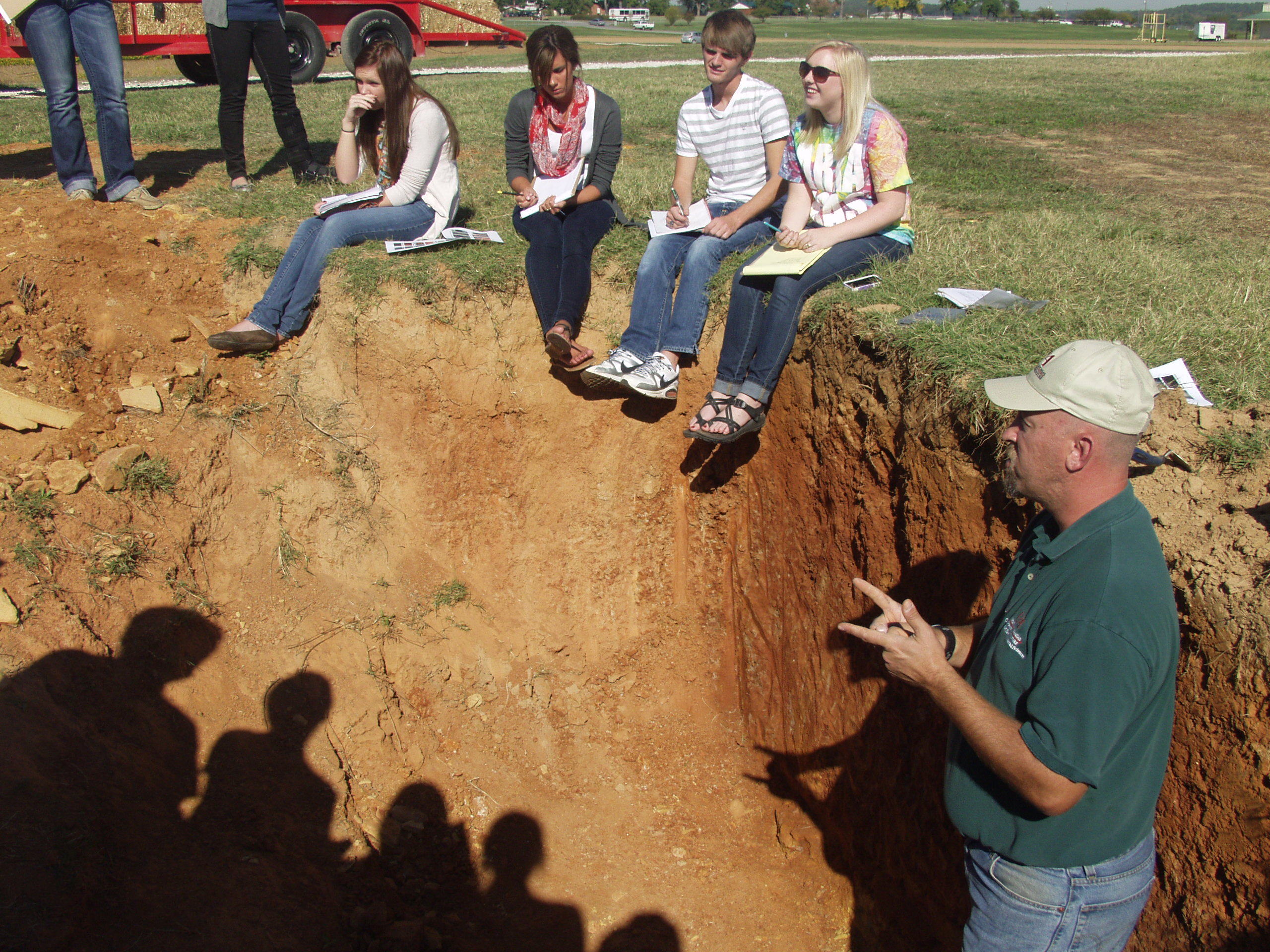
FAYETTEVILLE, Ark. – When a hay wagon full of students from Springdale Har-Ber High School pulled up to another stop on their field trip at the University of Arkansas Agricultural Research and Extension Center, they saw a man standing at the bottom of a large hole six feet deep who summoned them by saying, "Welcome to my office."
The man in the hole was Kristofor Brye, a professor of applied soil physics, who was preparing to introduce the students to the properties of soil and explain its impact on the world around them. Brye was one of several faculty members in the department of crop, soil and environmental sciences who hosted stops Tuesday, Oct. 4, at its third annual Environmental and Agricultural Sustainability Field Trip for more than 100 high school science students from Northwest Arkansas. Students from Fayetteville, Springdale and Mountainburg high schools also participated.
The students gathered around Brye's soil pit as he pointed to the layers of soil along the wall of dirt behind him. "Just about everything we eat in some way, shape or form had something to do with coming from the soil, whether it's grain or meat that we consume or that were fed plant materials that were growing in the soil," Brye said.
Besides the importance of soil in the growth of the fiber that is the source of clothing and for growing the trees that provide wood for housing, Brye emphasized the vital role that soil plays for water that works its way into and through the ground.
"The soil acts as a filter," he said. "It takes out some of the bad things we don't want to consume, it adds other things. We don't want the soil washing off into our streams and lakes and into the Gulf of Mexico. We want the soil in place so it can serve the best use that we can put it to."
Brye then explained the relationship between the colors of the soil layers the students viewed in the pit. "All you have to do is look at the color and you can tell a whole lot about the properties of those soils," he said. Upper parts of the soil are dark where roots and organic matter are concentrated. The red or orange soil layers have higher concentrations of iron that have been exposed to oxygen. If the soil is saturated with water and the oxygen is depleted, the soluble iron floats away and a gray color replaces the orange. The gray color in the soil layer means that's where the water has been and indicates how close the water table fluctuates toward the surface, which is important information to people who use septic systems, for example.
"We have to have people in various jobs with the skill of being able to look at the soil, describe its characteristics and use where it is in the landscape to interpret how do we best use that soil," Brye told the students.
The students spent more than two hours traveling across the Division of Agriculture's research facilities north of the university's main campus. With six wagons of science students working their way around the complex in shifts, they met for about 15 minutes in small groups with each of the faculty and staff members who explained their areas of research.
In addition to hearing Brye's introduction to soil, the students heard presentations in the field from Chuck West, a professor of forage and biomass physiology and ecology who discussed bioenergy crop production; Pengyin Chen, a professor of plant breeding and genetics who showed the impact of soybean research with an array of soy-based products spread on a table; John Mattice, a research associate professor of pesticide residues who demonstrated the use of charcoal to protect ground and surface water; Ron Cox, an assistant farm manager who explained the Division's use of cooking oil from food service units to make biodiesel, and Larry Purcell, a professor of crop physiology who reviewed the role of water conservation in Arkansas crop production.
"The high school teachers are really happy with what the students are learning on the field trip," said Holly Yeatman, the recruiting coordinator for the crop, soil and environmental sciences department. "They are exposed to so many issues that they don't run across in their everyday life. The students love it and we always get really good marks from them about what they got to see. The teachers find it very applicable to what they are teaching in their classes."
Topics
Contacts
Dave, Edmark
Agricultural Communication Services
479-575-6940, dedmark@uark.edu
Holly Yeatman,
Department of Crop, Soil, and Environmental Scienc
479-575-2347, hyeatman@uark.edu
Kristofor Brye,
Department of Crop, Soil, and Environmental Scienc
479-575-5742, kbrye@uark.edu